What is ecological energetics?
Ecological energetics is the study of movement of energy and materials through ecosystems. Different organisms can be assigned to different trophic levels within ecosystems.This helps ecologists describe the transfer of biomass and therefore energy from one organism to another through food chains and webs (who eats who). Ultimately, this energy will be degraded and lost irretrievably from the system as heat.
The total energy in the universe hasn’t increased or decreased since the Big Bang, when the universe began. Over time, this energy is being dispersed over a larger area as the universe expands and cools. Energy cannot be created or destroyed.
What questions do biologists ask?
You can ask many scientific questions about the food chains, food webs, productivity and trophic pyramids in freshwater habitats. Here are some examples.
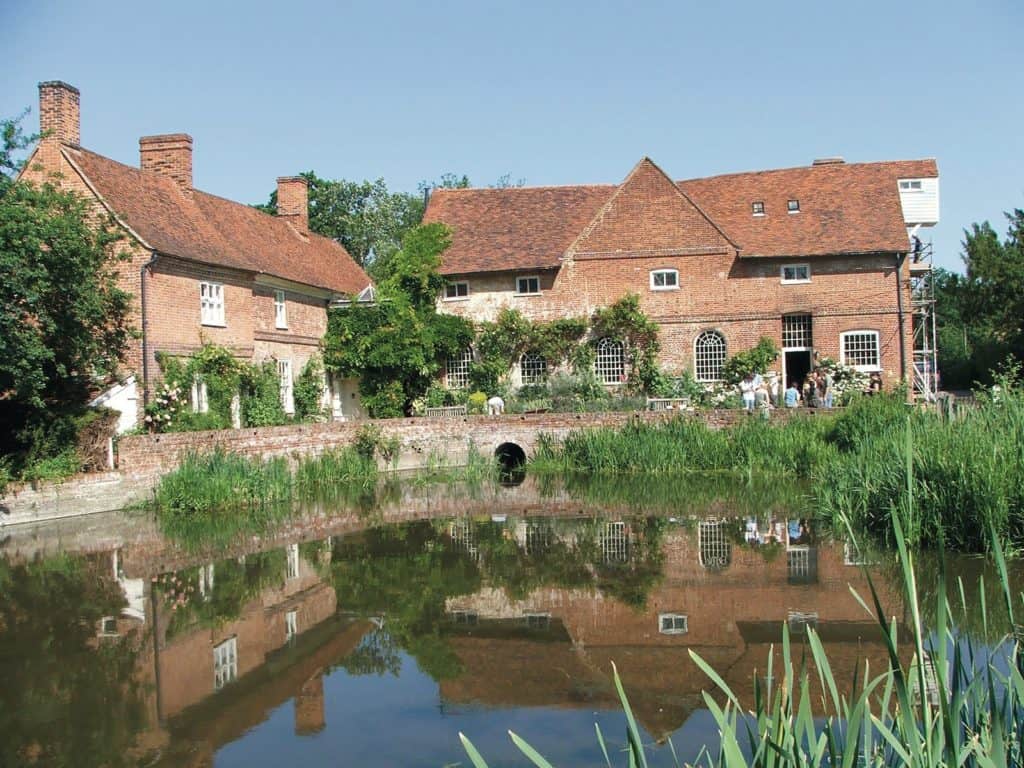
- What are the producers, primary consumers and secondary consumers here?
- Can you draw a food web for this pond?
- How would you use sampling to construct a pyramid of numbers for this pond?
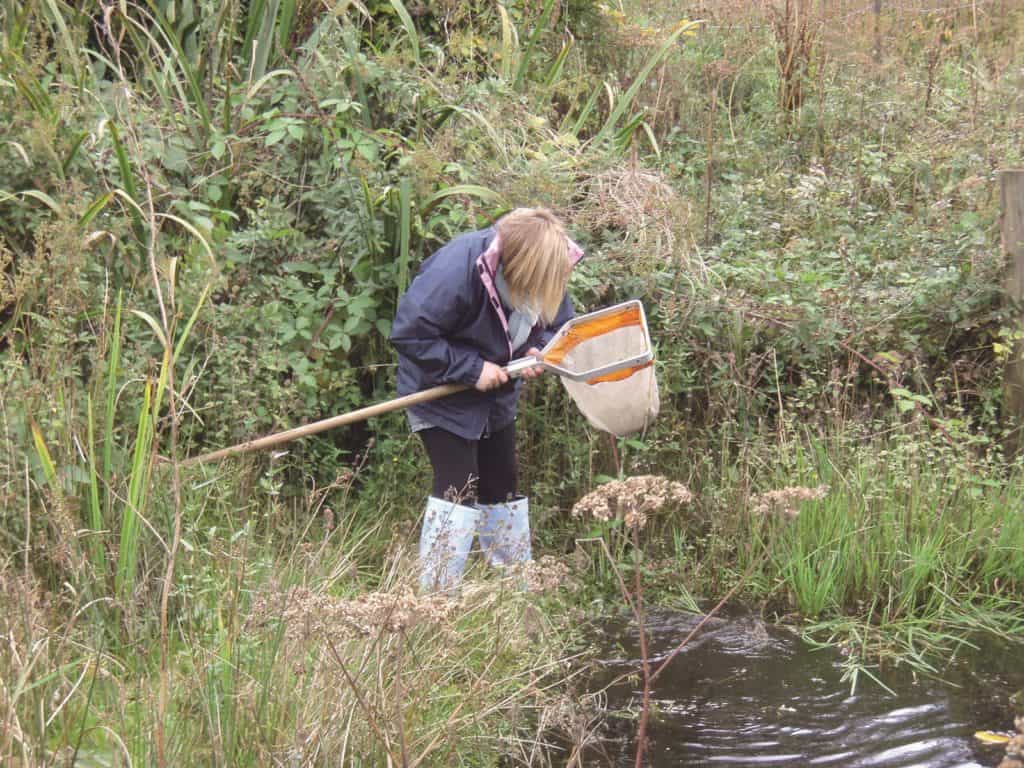
- How could you measure the primary productivity of this pond?
- Can you calculate the % energy transfer between producers and primary consumers?
- Why is energy lost between trophic levels?
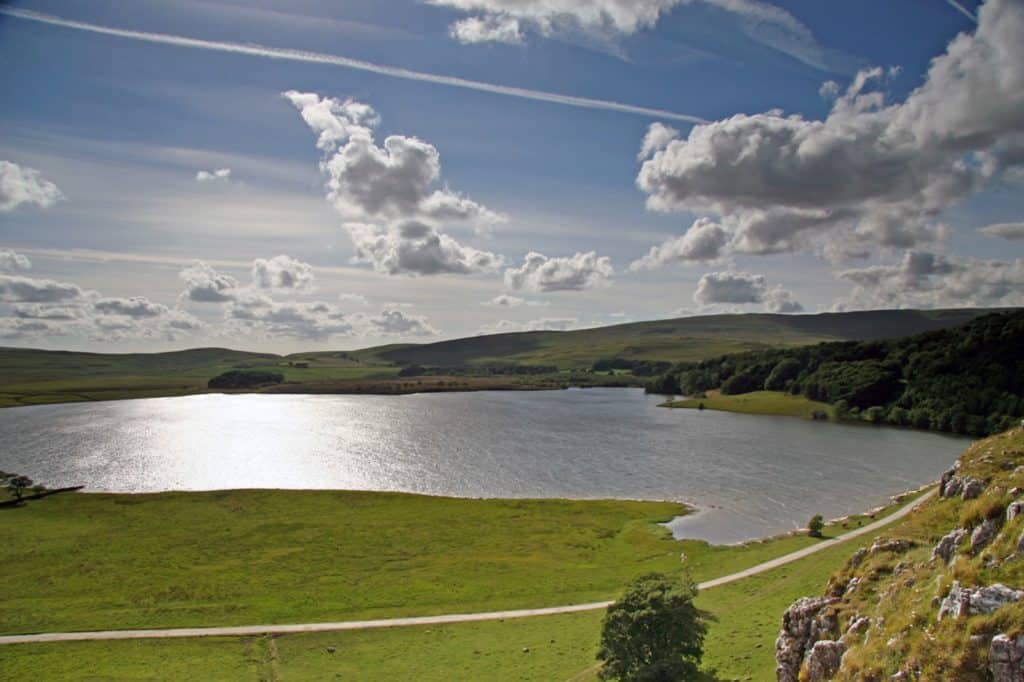
- How would you measure the biomass and energy content of fish in this lake?
- Would your fieldwork measurements of the biomass and energy content of fish be reliable?
- Why might the biomass of fish in this lake have decreased in the last 30 years?
What questions could you investigate with fieldwork?
Here are some examples. Each research question has been split into 2 or 3 sub-questions.
| Research question | Sub questions |
|---|---|
| How does abundance at each trophic level relate in a pond ecosystem? | What are the producers, primary consumers and secondary consumers in the pond? How can you use sampling to construct a pyramid of numbers for this pond? Why are there different numbers of indiviuals at each trophic level? |
| How and why does net primary productivity differ between Pond X and Pond Y? | How can you measure NPP (GPP and R) in the two ponds? Are there any abiotic differences between the two ponds? How might your results change over the year? |
|
What percentage of the sun’s energy fixed by the producers get transferred to the top consumers in this pond? | Can you use sampling to estimate the energy content at each trophic level? What is the % energy transfer at each trophic level? How is energy lost between trophic levels? |
Synoptic links
A good investigation will make links between different parts of the A-Level Biology specification. Here are some possible synoptic links for investigations into freshwater habitats.
| Synoptic link | Detail |
|---|---|
| Adaptation | r and K strategies – many herbivores are r-selected while top consumers are more K-selected (but there are exceptions!) |
| Transpiration and gas exchange | Respiration as a major source of energy loss between trophic levels. Light and dark bottles |
|
Nitrogen cycle | Legumes with nitrogen-fixing bacteria in root nodules, free-living nitrogen-fixing bacteria in soil e.g. Azotobacter, ammonification by fungi and bacteria |
| Photosynthesis | Limiting factors such as dissolved nitrogen and phosphorus, sunlight and dissolved oxygen. Light and dark bottles |
| Conservation | Removing or adding organisms at one trophic level may have a knock-on effect on other trophic levels |
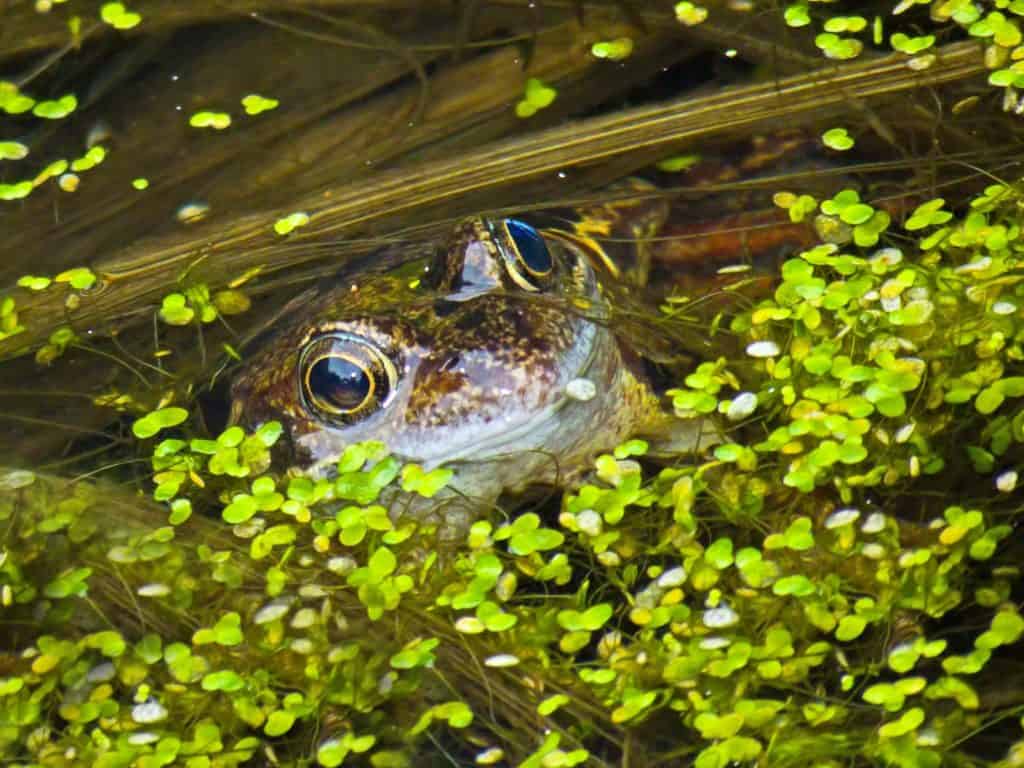
Energy transfer in freshwater food webs
Primary production is the start of the food web; plants fix energy and carbon into the system through photosynthesis. The food that this generates will in turn be consumed by the herbivorous creatures like mayflies. This second layer of any food web could be described as the secondary production within the ecosystem. It is this group that may be eaten by the carnivores.
Producers
Primary producers are organisms that take in light energy or inorganic chemicals from external energy sources and synthesise them into organic compounds using photosynthesis or chemosynthesis. The primary source of energy for almost all ecosystems on Earth is the Sun. Producers are always the first trophic level.
Plankton refers to organisms that live in open water and have little or no control over where they go. Fish are not planktonic as they can move and determine which way to go. Animals of open water that have the ability to swim purposefully and powerfully are called nekton. Most plankton is microscopic, especially that found in freshwater.
All plankton is divided into the plant-type plankton, the phytoplankton, and the animal plankton, zooplankton. The latter can be further sub-divided into the temporary and permanent zooplankton. In freshwater the temporary plankton is very limited.
Phytoplankton
These are the producers of energy and may be the base of many food webs. The principle component is the diatom, a form of alga. The basic form is a single-celled organism with the outer wall made from a high level of silica. This is one of the most important nutrients needed for growth. They multiply by cell division and if there is sufficient silica in the water the cells will grow and then split again. Sometimes the cells do not separate and remain together so that chains of diatoms form. Phytoplankton is very productive. Although at any one time the amount of primary production is limited (called standing crop) over a period like a year the net productivity can be higher than a meadow. This is down to the ability for diatoms to quickly multiply, less than half an hour to double. Only a few diatoms need survive and they can quickly reproduce.
Diatoms have diurnal rhythms in the water column. As soon as the sun is up they commence photosynthesis. The process generates oxygen and so the diatom becomes buoyant and begins to rise in the water. This causes it to move closer to the surface and gain more light for maximum photosynthesis. Of course, when the sun sets food production halts, no oxygen is formed and is used up. Buoyancy is lost and it starts to sink. If it sinks below the lit zone before photosynthesis starts the next day it will continue to sink and dies on the bottom.
Zooplankton
The animal plankton will need to follow the phytoplankton. Some of these animals will be herbivores eating the diatoms. Daphnia moves using its antennae but the degree of jerky movement is quite limited and so is referred to as plankton. To help them with their buoyancy during summer months they develop an enlarged head! Other animals in the plankton are carnivores, e.g. Cyclops, and will eat the small Daphnia. The density of zooplankton is linked to the density of diatoms and often the release of animal young is synchronised with the time of year and blooms.
Consumers
Consumers are organisms that ingest organic compounds to obtain energy. An organism that eats a primary producer is called a primary consumer. An organism that eats a primary consumer is called a secondary consumer. There is rarely enough energy or stored biomass available in an ecosystem for more than a quaternary consumer.
These relationships can be represented in a food chain or web. Not all energy is transferred from one trophic level to the next. The number of organisms, biomass and energy at each trophic level can be represented as a pyramid.
Detritivores
Detritivores or decomposers feed on dead or decaying organic matter to obtain energy. They form an important part of any food web as they release energy back into the ecosystem. Just like on land, there are many animals involved in the decay process. Various shortened terms can be used.
- DOM: Dissolved Organic Matter
- FPOM: Fine Particulate Matter
- CPOM: Coarse Particulate Matter
The table shows how a fallen leaf can be converted into FPOM, suitable for filter feeders to consume.
| Time (days) | Stages | Process | Weight loss |
|---|---|---|---|
| 1 | Leaf arrives | 0 | Gets wet |
| 3 | Leaf saturates with water | 5-25% | Soluble material leaches out of the leaf to become DOM |
| 10 | Microbes colonise the leaf which has become soft and damaged by possible movement | 5% | Respiration of material by microbes begin to mineralise to CO2 |
| 20-50 | Invertebrates colonise and provide physical breakdown while microbes continue to chemically breakdown cells | 20-35% | The microbes create an increase in the protein content available; ideal for animals that are colonizing and eating the leaf |
| 100-250 | The leaf is converted to FPOM | 15-25% | Animals continue to feed and release faeces, thus breaking the organic matter into FPOM |
Freshwater habitats
Freshwater habitats can be divided into two broad categories:
- Lentic freshwater: ponds and lakes, where the water is still
- Lotic freshwater: streams and rivers, where the water is moving
Lentic freshwater: ponds and lakes
Primary productivity can be high in ponds. In turn this leads to high numbers of consumers and detritivores.
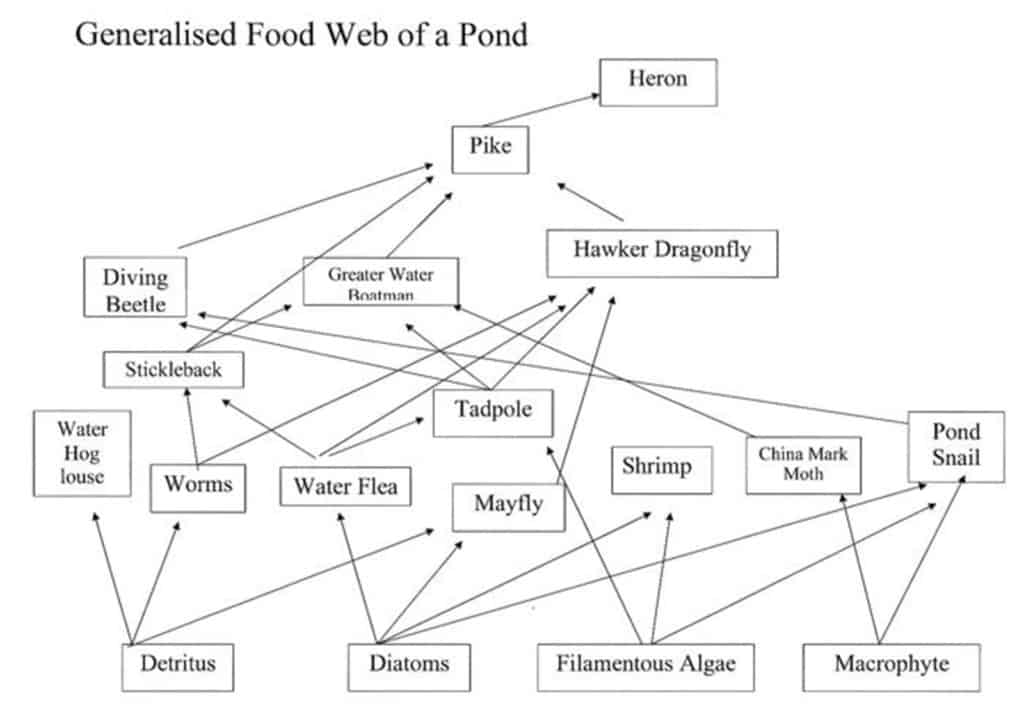
What factors affect primary productivity in ponds and lakes?
1. Light
For much of freshwater the primary source of energy is sunlight. But the amount of sunlight which penetrates the water can vary due to:
- time of day
- season
- depth
- turbidity of the water (how clear the water is)
- amount of cloud cover
- altitude of the pond or lake
On the equator in the middle of the day light rays may hit the water at a right angle. 99% of the light is absorbed by the water, with very little light reflected from the surface. However, as latitude increases, and as the angle becomes more acute, especially in the amount reflected increases while the amount absorbed decreases. At 45 degrees it is about 90% absorption. At 10 degrees about 25% is absorbed.
If the water is crystal clear, light may penetrate over 40 metres down into a lake. However the intensity will be extremely low, just a few percent of what was at the surface. By 10 metres depth already two thirds of the light has disappeared.
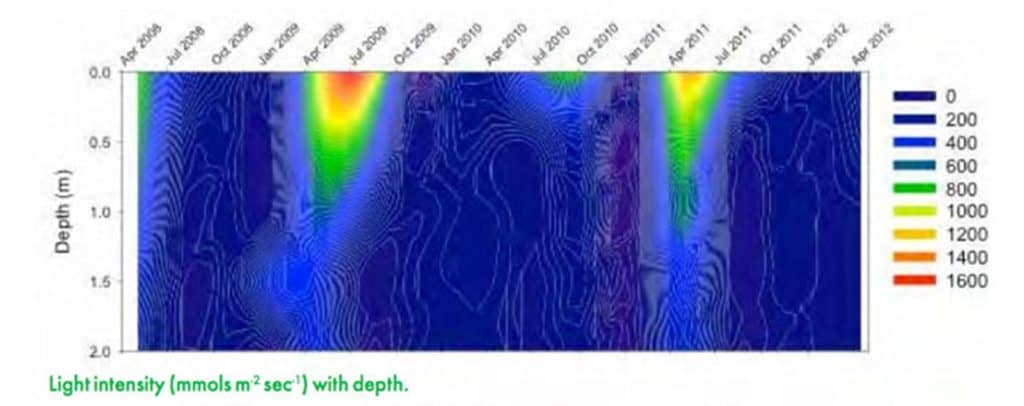
As well as light intensity, the wavelength of light is also important. On land, yellow-green light (the middle bands of light) are of least importance to plants whilst blue and red light (the two extremes of the visible spectrum) are the most important. This latter group penetrate water quickly but do not go deep. Green penetrates the furthest. This means that the green plants need to remain near the upper regions of the photic zone as that is where the light is most suitable for photosynthesis. Some plants, especially algae, will be able to survive lower down as they produce specialised accessory pigments to pick up the wavelengths of light that will pass into the deeper areas. They appear brown or even black.
Turbidity may be generated by organic matter in the form of detritus from decay or it could be in a peaty area where humic acid flows into the lake. This can create very dark water. Alternatively high nutrient levels will encourage high densities of plankton to grow.
2. Nutrients
There are several major sources of nutrients in ponds and lakes:
- water flowing into the pond or lake carrying dissolved minerals from rocks that the water flows over and
- soil washed from the banks and bed
- dissolved minerals in rainwater
- nutrients derived from organic matter
The dissolved minerals present will depend very much on the geology of the land from which the water inflow crosses.
In uplands of granite and other igneous rock this may be quite low. Calcium ions are essential for maximising population densities as it is needed for skeletal tissue, cell walls and shells in molluscs. Nitrogen enters in the form of ammonia or nitrates. The latter may be due to run-off from agricultural land and will encourage eutrophication. This means a substantial growth of plant material. Phosphate occurs naturally in small amounts and combines with iron to form ferric phosphate, precipitating to the benthic region. However, phosphate is now a significant pollutant of water entering from farmland and will also result in eutrophication.
Organic matter is an important source of nutrients. Decomposition releases valuable nutrients and is vital for the recycling of materials within freshwater ecosystems. This is called autochthonous material – materials obtained through recycling. Leaves falling from trees in autumn may be blown significant distances but the moment they touch the surface tension they stop and eventually sink to be trapped and decomposed. Nutrients derived from matter originating outside freshwater are called allochthonous.
3. Oxygen
Freshwater animals use oxygen that is dissolved in the water. Oxygen is sometimes in short supply. The lower the temperature the higher the saturation of oxygen. Conversely the warmer the water gets the lower the amount of oxygen that can dissolve in it.
Even when it is fully saturated water contains little oxygen. At 5 degrees (and at normal air pressure) one litre of water contains only 8.9 cubic centimetres oxygen and at 20 degrees it contains 6.4 cubic centimetres. At higher altitudes this lessens but the lowering level of oxygen may be compensated for by the reduction in temperature that allows a higher amount to saturate the water. The amount of oxygen consumed by animals will increase as temperature rises.
Oxygen is essential for most of the life in freshwater. Some will be able to live anaerobically in the mud. They may either be permanent anaerobes, e.g. some types of bacteria, whilst others may be able to survive short periods without oxygen, e.g. chironomid larvae. But the majority of organisms need a steady supply of oxygen and if the temperatures rises this will be a problem.
The rate of decomposition within the benthos will be determined by the amount of oxygen present. In oligotrophic lakes the oxygen levels may well be moderately high in the benthos compared to eutrophic ones that can be deoxygenated.
4. pH
pH can vary enormously between ponds and lakes, due to bedrock, topography and even the species of plant present.
The most significant aspect to pH is the amount of carbonic acid present. Carbon dioxide disolves in water to produce this and so it is a measurement of the level of CO2 available for photosynthesis. The ions dissociate to yield hydrogen and hydrogen carbonate. Measurement of the pH of a pond over a 24 hour period will demonstrate this well. At dawn the water will be acidic due to the high level of carbon dioxide released through respiration by all the living organisms present. However, as the sunlight becomes available photosynthesis occurs and the level of carbon acid declines. By mid-day the water may become increasingly alkaline until the sun sets. With the reduction in light photosynthesis halts and only respiration is occuring in the organisms. pH decreases accordingly.
Some animals are specific to calcium-rich, alkaline water like the crayfish. Snails need calcium for their shells and so will be limited to water rich in this mineral. Plankton may also be specific to alkaline waters.
5. Temperature
Temperature is one of the major factors affecting freshwater ecosystems. Water has a high heat storage capacity, which means that freshwater systems have a smaller temperature range on both a yearly and a 24-hour timescale compared to terrestrial ecosystems. However, the main effects of temperature are:
The reason that organisms are affected by temperature is largely due to the fact that they are cold blooded or poikilothermic. The external environment will determine their internal temperature and therefore metabolic activity.
Thermal stratification
The water in a pond and lake is warmed by solar energy. If the pond is very shallow there could be a substantial increase in temperature over a diurnal period with cooling at night. With the high heat storage capacity the larger the water body the less effect the sun will have over the day. However, the upper region of a lake will warm in the sun and, if wind turbulence is low, an underlying cool layer will be present. This is thermal stratification and is very important in determining other abiotic and biotic factors. Remembering that very cold water is at its most dense the warm water at the surface (called the epilimnion) will be least dense and “float” over this substantially cooler, dense water layer (called hypolimnion). The water between the two will show a rapid change in temperature over a relatively short distance. This sharp change in temperature is called the thermocline.
This stratification tends to be present during summer and winter when disturbance is at a minimum. In spring and autumn there is the greatest chance of wind-induced wave action. In turn this creates a greater mixing of the layers and the thermocline is most likely to disappear. The position of the thermocline (the most important physical event in a lake) in any lake will vary according to factors such as size of water body, depth, and latitude.
The two diagrams show the results of monitoring at two shallow bodies of water between 2008 and 2012. Source: OPAL Water Centre.
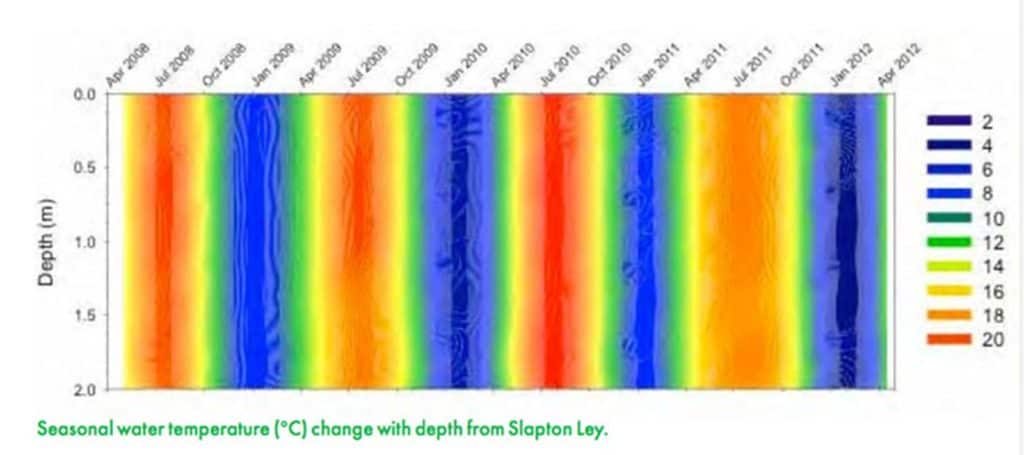
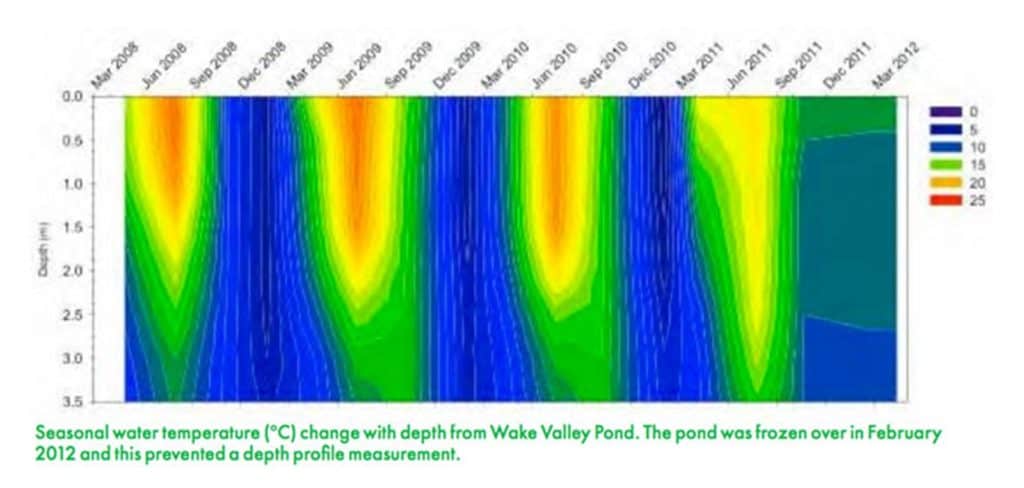
Lotic freshwater: streams and rivers
Primary production can be much lower in rivers than in ponds. Large plants cannot survive in fast-moving water where there is little soil and where the plant may be washed away downstream. Single celled algae can grow well in streams and rivers, attaching to the stones and rocks of the river bed.
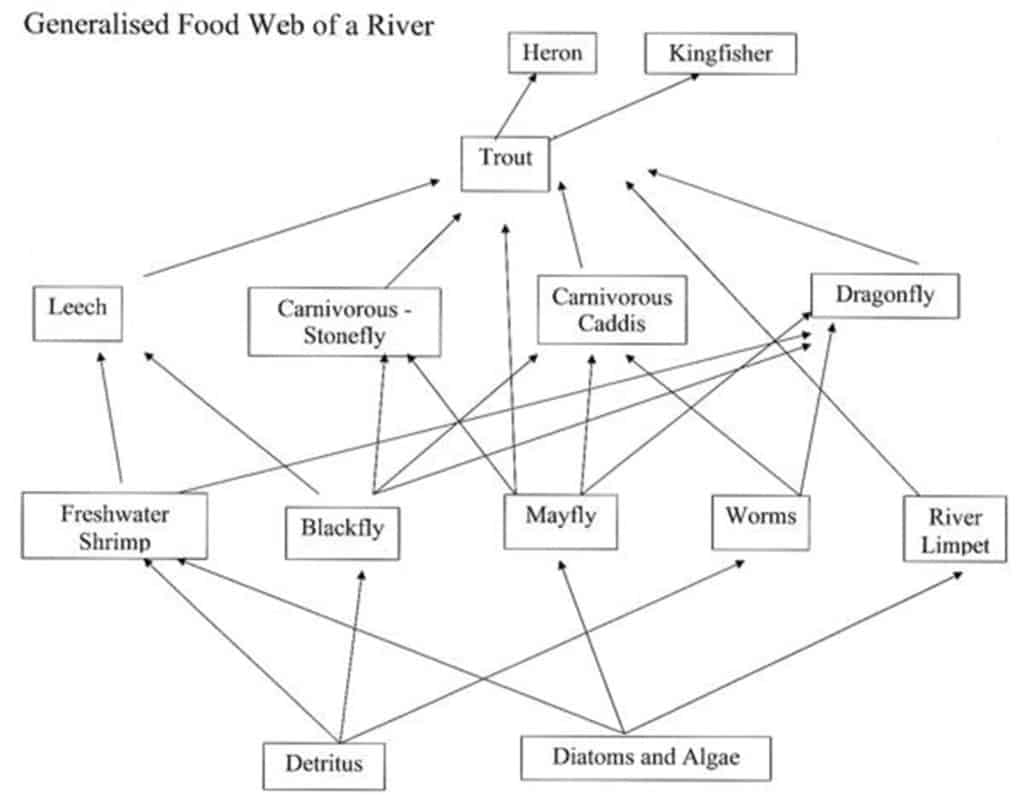
What factors affect primary productivity in ponds and lakes?
1. Water velocity
Velocity (the speed of the water) has a major impact on freshwater animals. Adaptations to survive in high velocity channels include
- streamlined body shape (low and flat)
- strong swimmer
- anchor to the river bed
- burrowing into sediment
Plants are unlikely to take root unless the substrate is soft sediment.
2. Substrate
The substrate is the material on the river bed and in the river banks. It is made up of inorganic matter (silt, sand, pebbles and rock) and organic matter (coarse or fine particulate organic matter, such as dead leaves and animals).
For many freshwater animals, the most important feature of the substrate is the size of the spaces between different particles, such as pebbles or sand. These gaps provide cover from predators, areas of reduced velocity and a place where organic material becomes trapped. Animals that live in spaces less than 0.5 mm in size , between sand grains, are called meiofauna and can be abundant.
Alkaline substrate, such as chalk or limestone, are important for molluscs.. Dissolved rock releases a large amounts of calcium necessary for shell growth.
3. Temperature
Temperature varies
- between different parts of the river
- on a diurnal basis (during a 24 hour period)
- on a seasonal basis (during a year)
Altitude, local climate and vegetation on the river banks influence temperature.
4. Oxygen
Freshwater animals use oxygen that is dissolved in the water. Freshwater can be depleted of oxygen or it can be saturated or even super-saturated. Oxygen content at saturation depends on temperature, and it decreases as the water temperature rises. Super-saturation can occur in turbulent streams and where plants are actively photosynthesising. Oxygen depletion is usually the result of the respiratory activity of organisms following organic pollution.
Even when it is fully saturated water contains little oxygen. At 5 degrees (and at normal air pressure) one litre of water contains only 8.9 cubic centimetres oxygen and at 20 degrees it contains 6.4 cubic centimetres. At higher altitudes this lessens but the lowering level of oxygen may be compensated for by the reduction in temperature that allows a higher amount to saturate the water. The amount of oxygen consumed by animals will increase as temperature rises.
Oxygen is essential for most of the life in freshwater. Some will be able to live anaerobically in the mud. They may either be permanent anaerobes, e.g. some types of bacteria, whilst others may be able to survive short periods without oxygen, e.g. chironomid larvae. But the majority of organisms need a steady supply of oxygen and if the temperatures rises this will be a problem.
Pools and riffles
Many upland streams feature of sequence of pools and riffles. These are often no more than a few metres in length, so they are practical to investigate for fieldwork.

Secondary and Further Education Courses
Set your students up for success with our secondary school trips and courses. Offering excellent first hand experiences for your students, all linked to the curriculum.
Group Leader and Teacher Training
Centre-based and digital courses for teachers
Experiences for Young People
Do you enjoy the natural world and being outdoors? Opportunities for Young People aged 16-25.
